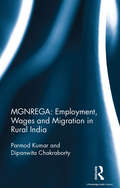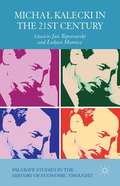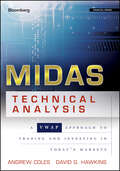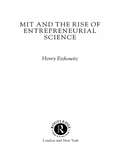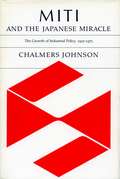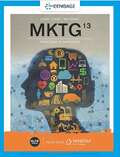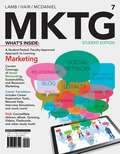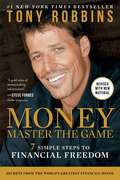- Table View
- List View
MGNREGA: Employment, Wages And Migration In Rural India
by Parmod Kumar Dipanwita ChakrabortyThe Mahatma Gandhi National Rural Employment Guarantee Act (MGNREGA) was enacted in India with the multiple objectives of providing employment in a rights-based framework, addressing rural poverty, checking migration, and building rural infrastructure. As such, every year around 15–20 per cent of households in India overall and 30 per cent in rural India receive some form of employment share under the MGNREGA programme. This volume looks at various aspect of the scheme, its linkage with employment, agricultural wages, livelihood and food security, gender issues, and migration in rural India. It also discusses challenges in implementation, hurdles and the relative successes of the scheme. Based on primary survey data from 16 major states in the country, the findings of the study provide key insights into MGNREGA and assess the implications for other welfare-oriented programmes. Rich in empirical data, this volume will be useful to scholars and researchers of political economy, economics, agriculture, rural development and sociology, as well as policymakers and nongovernmental organisations.
MIA: Profit at the Base of the Pyramid
by Aldo Sesia Lynda M. Applegate Sarah Mehta Jose Antonio Davila CastillaIn January 2016, Guillermo Jaime had just returned home to Mexico City after attending a Harvard Business School executive education program. Jaime was the founder and CEO of Mejoramiento Integral Asistido (MIA), a company providing affordable housing to low-income Mexicans living at the base of the pyramid (BOP), defined as those living on less than $10 per day. Since its launch in 2009, MIA had built nearly 25,000 homes-which provided safe shelter to more than 100,000 Mexicans-while generating an earnings before interest, taxes, depreciation, and amortization (EBITDA) margin of over 8%. At the executive education program, Jaime had learned that entrepreneurs could build on their unique attributes and capabilities to expand and grow their businesses. Should he continue to expand the services MIA offered to BOP customers? Could he leverage what made MIA unique-offering affordable homes for its BOP customers in Mexico-to fulfill other critical needs at the BOP for water, clean energy, and health care services? Jaime was an expert in housing, but could he translate that expertise to such diverse sectors? If so, how should he begin?
MICHAł KALECKI IN THE 21ST CENTURY
by Jan Toporowski Łukasz MamicaLeading experts on Kalecki have contributed special essays on what economists in the 21st century have to learn from the theories of Kalecki. Authors include surviving students of Kalecki, such as Amit Bhaduri, Mario Nuti, Kazimierz Laski Jerzy Osiatynski, and Post-Keynesian economists such as Geoff Harcourt, Marc Lavoie, and Malcolm Sawyer.
MIDAS Technical Analysis: A VWAP Approach to Trading and Investing in Today's Markets (Bloomberg Financial #148)
by Andrew Coles David HawkinsThis book provides a new, powerful twist to MIDAS technical analysis, a trading method developed by the late Paul Levine. The authors show how to employ MIDAS in trading, from recognizing set ups to identifying price targets. The book explains the basics of MIDAS before demonstrating how to apply it in different time frames. Further, it extrapolates how MIDAS can be used with other more conventional indicators, such as DeMark or moving averages. In addition to introducing new indicators that the authors have created, the book also supplies new computer codes.
MINI USA: Finding a New Advertising Agency (A)
by David B. GodesSelling an intangible like advertising services is a difficult task. The first step is to understand how brands buy these services. What are they looking for? What do they need to learn? How do they go about assessing things like creativity, trust, and loyalty? This set of cases puts the students into the roles of the seller (an advertising agency named Butler, Shine, Stern and partners) and the buyer (MINI USA) and asks them to develop a sales strategy for advertising services. As outlined in the (B) case, the agency developed an intriguing and original approach to assessing the intangibles and students are asked to react to it from a sales perspective and to attempt to generalize the approach to other sales domains.
MINTing Innovation at NewYork-Presbyterian (A)
by David Kiron Richard G. HamermeshSeveral top surgeons at NewYork-Presbyterian hospital (NYP) are receiving financial and administrative support to advance their surgical device inventions through the earliest stages of commercialization.
MINTing Innovation at NewYork-Presbyterian (B)
by Michael Norris Richard G. HamermeshThis short (B) case gives an update on the progess that MINT has made at NYP since the end of the (A) case.
MIS
by Hossein BidgoliLearn the principles of MIS as you explore the latest developments and industry trends with MIS 10. This practically focused approach helps you master foundational MIS concepts that will guide your career. You examine the latest topics, such as cloud computing, AR/VR, quantum computing and blockchain, with the most current MIS title on the market. Have you ever wondered what you would have done as a company leader in a critical moment? With this edition's MindTap digital experience, you can strengthen your decision-making skills with "YouDecide" -- new interactive case studies that bridge technology and business strategy and position you as the decision maker.
MIT Mystery Hunt: The Answer is Secondary
by Willy Shih Karen RobinsonThe MIT Mystery Hunt is an annual puzzle-based scavenger hunt at MIT. It is run every year by a different team, and every year is slightly different as teams try new ideas and decide whether to keep or ignore new ideas from previous years. As the Mystery Hunt has grown, organizers face the challenge of balancing efficient administration while keeping it free of excessive administration.
MIT and the Rise of Entrepreneurial Science (Routledge Studies In Global Competition Ser. #12)
by Henry EtzkowitzMIT and the Rise of Entrepreneurial Science is a timely and authoritative book that analyses the transformation of the university's role in society as an expanded one involving economic and social development as well as teaching and research. The Massachusetts Institute of Technology invented the format for university-industry relations that has be
MITI and the Japanese Miracle: The Growth of Industrial Policy, 1925-1975
by Chalmers JohnsonThe focus of this book is on the Japanese economic bureaucracy, particularly on the famous Ministry of International Trade and Industry (MITI), as the leading state actor in the economy. Although MITI was not the only important agent affecting the economy, nor was the state as a whole always predominant, I do not want to be overly modest about the importance of this subject. The particular speed, form, and consequences of Japanese economic growth are not intelligible without reference to the contributions of MITI. Collaboration between the state and big business has long been acknowledged as the defining characteristic of the Japanese economic system, but for too long the state's role in this collaboration has been either condemned as overweening or dismissed as merely supportive, without anyone's ever analyzing the matter. The history of MITI is central to the economic and political history of modern Japan. Equally important, however, the methods and achievements of the Japanese economic bureaucracy are central to the continuing debate between advocates of the communist-type command economies and advocates of the Western-type mixed market economies. The fully bureaucratized command economies misallocate resources and stifle initiative; in order to function at all, they must lock up their populations behind iron curtains or other more or less impermeable barriers. The mixed market economies struggle to find ways to intrude politically determined priorities into their market systems without catching a bad case of the "English disease" or being frustrated by the American-type legal sprawl. The Japanese, of course, do not have all the answers. But given the fact that virtually all solutions to any of the critical problems of the late twentieth century--energy supply, environmental protection, technological innovation, and so forth--involve an expansion of official bureaucracy, the particular Japanese priorities and procedures are instructive. At the very least they should forewarn a foreign observer that the Japanese achievements were not won without a price being paid.
MK Taxi: Private Chauffeur Service
by Andrew McafeeMK Taxi Tokyo has developed a system to allow customers to use their mobile phones to find and contact the cab closest to them, bypassing the dispatch center. The system, called the Private Chauffeur Service (PCS), makes use of NTT's i-mode service, which essentially turns mobile phones into small Internet terminals. MK worked with NTT to develop an application that physically locates each PCS caller, determines the closest cab, and automatically connects the customer with the cab's driver for a voice call. At the time of the case, Maasaki Aoki, the head of MK Tokyo, wonders how best to expand and enhance the PCS service.
MKTG
by Charles W. Lamb Joe F. Hair Carl McDanielLearn Marketing YOUR Way with MKTG! MKTG's easy-reference, paperback textbook presents course content through visually-engaging chapters as well as Chapter Review Cards that consolidate the best review material into a ready-made study tool. With the textbook or on its own, MKTG MindTap allows you to learn on your terms. Read or listen to textbooks and study with the aid of instructor notifications, flashcards and practice quizzes. Track your scores and stay motivated toward your goals. Whether you have more work to do or are ahead of the curve, you'll know where you need to focus your efforts.
MKTG (Mindtap Course List Series)
by Charles W. Lamb Joe F. Hair Carl McDanielMKTG from 4LTR Press connects students to the principles of marketing, bringing them to life through timely examples showing how they're applied at the world's top companies every day.
MKTG 7 (Marketing, 7th Edition)
by Carl Mcdaniel Charles W. Lamb Joseph F. HairThe book is introduces students to the world of Marketing and elaborates on market opportunities, product decisions, promotions etc.
MKTG Principles of Marketing (9th Edition)
by Carl Mcdaniel Charles W. Lamb Joseph F. HairMKTG 9 offers full coverage of course concepts through unique resources and features that reflect the natural study habits of students, accompanied by straightforward assignment options for instructors.
MKTG6
by Carl Mcdaniel Charles W. Lamb Joe F. HairCreated through a "student-tested, faculty-approved" review process with direct input from students and faculty, *MKTG6* is an engaging and accessible solution to accommodate the diverse lifestyles of today's learners. *MKTG6* employs up-to-date, relevant examples from a wide range of independent upstarts and larger companies students love. *MKTG6* also offers a dynamic range of web-based review and testing products to facilitate today's on-the-go lifestyle.
MOD Pizza in 2017
by Boris Groysberg Matthew PrebleThis supplement describes how MOD Pizza has grown between May 2015 (when the first case ends) and early 2017.
MOD Pizza: A Winning Recipe?
by Boris Groysberg Matthew Preble John D. VaughanScott and Ally Svenson, the founders of MOD Pizza, had to make a number of decisions in planning how to scale their small company. They wanted to grow MOD from 45 stores as of May 2015 to 200 stores by the end of 2016, and while the two believed that MOD could manage this growth from an operational standpoint, they wanted to make sure that MOD's culture was sufficiently strong to survive this rollout. The company had developed a strong culture, and the Svensons did not want MOD's core values and philosophies to be compromised as it rapidly expanded. To that end, they considered what the company needed to do in order to protect its core culture. Should it put rigid safeguards in place or trust that MOD could successfully scale its culture by hiring the right people and helping them develop as employees? The Svensons also discussed the possibility of an IPO at some point in the near future; what would this mean for its ability to stay true to its core values?
MOD Pizza: A Winning Recipe?
by Boris Groysberg Matthew Preble John D. VaughanScott and Ally Svenson, the founders of MOD Pizza, had to make a number of decisions in planning how to scale their small company. They wanted to grow MOD from 45 stores as of May 2015 to 200 stores by the end of 2016, and while the two believed that MOD could manage this growth from an operational standpoint, they wanted to make sure that MOD's culture was sufficiently strong to survive this rollout. The company had developed a strong culture, and the Svensons did not want MOD's core values and philosophies to be compromised as it rapidly expanded. To that end, they considered what the company needed to do in order to protect its core culture. Should it put rigid safeguards in place or trust that MOD could successfully scale its culture by hiring the right people and helping them develop as employees? The Svensons also discussed the possibility of an IPO at some point in the near future; what would this mean for its ability to stay true to its core values?
MOD Pizza: A Winning Recipe? (Abridged)
by Boris Groysberg Matthew Preble John D. VaughanThis is an abridged version of MOD Pizza: A Winning Recipe? Case study number 416-004. Scott and Ally Svenson, the founders of MOD Pizza, had to make a number of decisions in planning how to scale their small company. They wanted to grow MOD from 45 stores as of May 2015 to 200 stores by the end of 2016, and while the two believed that MOD could manage this growth from an operational standpoint, they wanted to make sure that MOD's culture was sufficiently strong to survive this rollout. The company had developed a strong culture, and the Svensons did not want MOD's core values and philosophies to be compromised as it rapidly expanded. To that end, they considered what the company needed to do in order to protect its core culture. Should it put rigid safeguards in place or trust that MOD could successfully scale its culture by hiring the right people and helping them develop as employees? The Svensons also discussed the possibility of an IPO at some point in the near future; what would this mean for its ability to stay true to its core values?
MONEY Master the Game: 7 Simple Steps to Financial Freedom (Tony Robbins Financial Freedom Series)
by Tony RobbinsTony Robbins turns to the topic that vexes us all: How to secure financial freedom for ourselves and for our families. &“If there were a Pulitzer Prize for investment books, this one would win, hands down&” (Forbes).Tony Robbins is one of the most revered writers and thinkers of our time. People from all over the world—from the disadvantaged to the well-heeled, from twenty-somethings to retirees—credit him for giving them the inspiration and the tools for transforming their lives. From diet and fitness, to business and leadership, to relationships and self-respect, Tony Robbins’s books have changed people in profound and lasting ways. Now, for the first time, he has assembled an invaluable “distillation of just about every good personal finance idea of the last forty years” (The New York Times). Based on extensive research and interviews with some of the most legendary investors at work today (John Bogle, Warren Buffett, Paul Tudor Jones, Ray Dalio, Carl Icahn, and many others), Tony Robbins has created a 7-step blueprint for securing financial freedom. With advice about taking control of your financial decisions, to setting up a savings and investing plan, to destroying myths about what it takes to save and invest, to setting up a “lifetime income plan,” the book brims with advice and practices for making the financial game not only winnable—but providing financial freedom for the rest of your life. “Put MONEY on your short list of new books to read…It’s that good” (Marketwatch.com).
MOOC Learning Platform Development
by Thomas Hanne Varun Gupta Durg Singh ChauhanThe work presented in this book is based on empirical study undertaken as a case study to understand the challenges faced in massively open online course (MOOC) based learning and experimentation to understand the challenges for presenting theoretical and practical courses. The book proposes a flexible online platform. This solution provides flexibility in distance learning processes including course enrollment, learning, evaluation, and outcome of degrees. The proposed system not only gives students freedom to choose their courses in accordance with their needs but also use earned credit towards online degrees of any university of their choice.
MOOCs and Open Education in the Global South: Challenges, Successes, and Opportunities
by Thomas C. Reeves Ke Zhang Thomas H. Reynolds Curt BonkWith e-learning technologies evolving and expanding at high rates, organizations and institutions around the world are integrating massive open online courses (MOOCs) and other open educational resources (OERs). MOOCs and Open Education in the Global South explores the initiatives that are leveraging these flexible systems to educate, train, and empower populations previously denied access to such opportunities. Featuring contributors leading efforts in rapidly changing nations and regions, this wide-ranging collection grapples with accreditation, credentialing, quality standards, innovative assessment, learner motivation and attrition, and numerous other issues. The provocative narratives curated in this volume demonstrate how MOOCs and OER can be effectively designed and implemented in vastly different ways in particular settings, as detailed by experts from Asia, Latin America, the Middle East, Africa, the Pacific/Oceania, and the Caribbean. This comprehensive text is an essential resource for policy makers, instructional designers, practitioners, administrators, and other MOOC and OER community stakeholders.
